-

人教版高中英语必修3Canada-the true north说课稿4篇
Good afternoon, teachers, It’s my great pleasure to be here sharing my lesson with you.The content of my lesson is Senior English Book 3 Unit 5 Canada —— “The true North”.I’ll be ready to begin this lesson from five parts. Analysis of the teaching material,the teaching methods,the studying methods, the teaching procedure,and Blackboard design.First, let me talk about the teaching material.Part 1 Teaching Material:This unit is about the introduction of Canada. By studying of this unit,we’ll enable the students to learn the geography, population, main cities, and natural beauty, natural resources of Canada. Through the training of the unit, it also requires students to learn some Language skills such as the expressions of position and emotions.So it plays an important part in the English teaching in this book.After studying the teaching material and analyzing the rule of children’s growing of mind,I think the teaching aims are the followings:1.Knowledge objects:(1) make the students learn some new words and phrases(2) make the students understand the content of the lesson.2.Ability objects:(1)To develop the Ss’ abilities of listening, speaking, reading and writing. Especially reading and speaking ability.(2) learn to talk about the characters of Canada in English(3)To train the Ss’ ability of working in pairs.3.Emotion objects:(1)Enable students to understand the characters of Canada..(2)Stimulate Ss to work hard to make China stronger.Part 2 Teaching Methods:I think helping students learn to master new words and phrases and improve the students’ reading and speaking ability is import and the difficult.According to the analysis of the teaching material and the import points and the difficult points,I will use the following teaching methods : question-guiding approach; fast-reading and careful reading; multi-media teaching methods; discussion

人教版高中英语必修4Theme parks说课稿3篇
The oldest and the most popular park in the worldenjoy the exciting activities thereget close to the life-size cartoon characters like Mickey Mouse and Donald Duck Step 3 Pre-reading1.What do you suppose a theme park is ?2.What do you think you can see in a theme park?(1.It is a kind of amusement park which has a certain theme – that the whole park is based on. 2.buildings, castles, statues, rare animals and birds, and so on.) Step 4 Reading ----- Theme Parks –---- Fun and More Than Fun1.Predict : Read the title and the pictures on P. 34 and PredictWhat is the meaning of the title “Theme Park – Fun and more than fun”?(The title means that theme parks are fun to visit, but that they can also be educational and can offer useful information.)2.Skimming Fast read and answer:What activities can we take in a theme park?Amusement park: Bumper car Merry-go-round slide bungee jumping Free-fall rides Horror films Pirate ship Ferris wheel roller coaster3.Scanning Read again and you will find various theme parks are mentioned in the passage . Then what are they ?Theme parks: Sports theme park History theme park Culture theme park Marine or Ocean theme Park Future park Science theme park Disneyland4.Careful reading and find the main idea of each paragraph:THEME PARKS---- entertaining/ educationalPara.1 Traditional parks are places to go for relaxation and to have time away from our busy lives.Para.2 Theme parks are different They’re large and full of things to do, see and buy.Para.3 Theme parks are built around a single idea or theme. One example is a sports park.Para.4 Another kind of theme park is historical more and cultural and can be educational.Para.5 Disneylandwas the first theme park. It is based on the fantasy life and characters of Disney’s films.Para.6 Some examples of educational theme parks include sea world parks and science parks.

人教版高中英语必修3Healthy Eating说课稿4篇
Language learning needs a context, which can help the learners to understand the language and then can product comprehensible output, so computer has the advantages to make the materials attractive.Part 3 Learning MethodsTask-based, self-dependent and cooperative learningPart 4 Teaching ProcedureStep One Lead-in“Interest is the best teacher.” Therefore, at the very beginning of the class, I should spark the students’ mind to focus on the centre topic “the band”. I’ll show some pictures of food to attract their attention and then bring some questions.Question:What kind of food they like?What should go into a good meal?The answers must relate to the diet. After this, the students will be eager to know something about a balance diet and this is the very time to naturally lead the class into Step 2Step 2 Reading for information: skimming and scanning In this step, I use Task-based Language Teaching method, which can give students a clear and specific purpose while skimming and scanning the context.Task 1 General ideaThe students will be asked to just glance at the title and the pictures of the passage, and then guess what they will read in the text. And they’ll be divided into groups of four to have a discussion.The purpose is to inspire the students to read actively, not passively. In addition, the task is to develop the students’ reading skill by making prediction and to encourage the students to express their thoughts in English and cooperate with each other.Task 2 Main idea of each paragraphCooperative learning can raise the students’ interest and create an atmosphere of achievement. Based on this theory, I divide the whole class into 4 groups to skim the whole text and get the main idea of each paragraph.

人教版高中英语必修4Working The Land说课稿3篇
Knowledge objectives:(1) to make Ss grasp the usage of words, expressions and sentence structures: statistics, struggle, thanks to, rid of, some patterns for persuasion, the “ing” form as subject and object;(2)to use learnt knowledge to persuade sb.Ability objectives:(1) to develop Ss’ reading skills(skimming, scanning, word guessing);(2) to improve Ss’ speaking, communicating and cooperating skills.Emotional objectives:to make Ss know the contribution of Yuan,and learn his spirit and his simple life time.Teaching important and difficult points:(1) some words, expressions and sentence structures mentioned above;(2)the content of the text;(3)training their reading and speaking skills.Teaching methods: CLT, TBLT,QT.Learning strategies: CLS, QLS, TBLS.Teaching procedures:Step 1 lead-in: (1) teacher plays a piece of recent news from CCTV about the harvest of the super hybrid rice, and ask students whether they know Yuan or not, and talk about him and his contribution.(2)Brain storm: let Ss describe Yuan in their minds including his appearance, his living condition and so on.Step 2 fast reading tasks:(1)teacher introduces Yuan and super hybrid rice(2)make Ss read the text as fast as possible with questions. Such as: what’s the general ideaof this passage? What’s Yuan’ dream? (skimming and scanning skill)Step 3 intensive reading tasks(1)let Ss read the text silently, find topic sentence of each paragraph and draw the difficult sentences and the knowledge what they don’t understand.(words guessing)(2)teacher and Ss talk about the important words, expressions and sentences together, and ask Ss to retell the content of the text.(summarizing and paraphrasing)(3)teacher summarize this part.(4) read again following the courseware.

人教版高中英语必修5Great scientists说课稿4篇
通过写文章梗概,培养学生综合运用语言的能力,学习用恰当的英语描述科学家的故事。这是本课的教学难点。教师可以使用完形填空的方式来帮助学生整理语篇,从而来降低难度。本课的教学重点的突破方法是:在阅读前,让学生初步了解得出科学观点所需要的基本程序,从而轻松而自然地导入文章的阅读;在阅读过程中,由易到难设计快速阅读和精读的问题,层层推进各种阅读活动,让学生对阅读内容从整体感知到细节理解,最后深层读懂整篇文章,同时加强阅读策略的指导,让每个学生都主动参与课堂教学活动,最终达到提高阅读能力的目的。Step 4 Post-readingGroup Activities四人小组共同合作,在老师的适当指导下,就以下2个问题展开讨论,让学生就所知、所学、所感和所想融入话题,然后抽若干同学代表作小组发言。1. What do you think about John Snow, and what should we learn from him?2. Cholera was 19th century disease, which two diseases are similar to cholera today? Why?

人教版高中英语必修5Life in the Future说课稿5篇
Good afternoon, everyone. It’s my great pleasure to be here sharing my lesson with you. The content of my lesson is Senior English for China Book5 Unit 3 Life in the Future. I’ll be ready to begin this lesson from six parts: Analysis of the teaching material, Analysis of the students, Teaching aims and important and difficult points, Teaching methods and aids, Teaching procedures, and Blackboard design. First, let me talk about the teaching material.Part 1 Analysis of the Teaching Material:This unit is about what human beings’ life will be like in about one thousand years. By studying of this unit, we’ll Enable the students to know the changes in humans’ life and some new inventions bringing about the change and develop the interest in science. This lesson plays an important part in the English teaching in this unit. This is an important lesson in Book Five. From this lesson, it starts asking the Ss to grasp contents of each passage. Therefore, this lesson is in the important position of the teaching material. If the Ss can learn it well, it will be helpful to make the Ss learn the rest of this unit.Part 2 Analysis of the SsAs Senior2 Ss, they are at different levels of English fluency, some of them have lost interest in English. So during the lesson, I arrange a variety of activities to let all of them join in to attract their interest and let them be confident and taste the joy of success.

人教版高中英语必修5Making the news说课稿4篇
今天我们来介绍一下必修五第四单元的授课方式。这个单元的题目是Making the news。应该是学生比较感兴趣的话题,学生往往对新闻工作充满好奇,所以我们可以利用这个机会多设计一些师生互动和学生互动,来激发起学习的积极性,提高学习效率。同时我们可以利用这个单元不仅帮助学生掌握语言知识,培养语言能力,同时让其了解新闻工作的重要性,培养起社会智能感。这个单元分为六个课时,它的教学目标是这样的:语言目标是掌握词汇表中的常用单词和短语,掌握倒装句的一些基本用法。 技能目标是能初步掌握约会的基本句型并在真实的场景下正确运用。新闻报道类文章的写作技能。采访的基本规范和沟通技能。情感目标是对新闻报道的客观性和真实性有更好的理解。对新闻记者的职业有更深入的了解,并能体会其工作的重要性。下面我们来介绍一下第一课时的授课方式,第一课的教学目标是这样的第一课时的教学目标语言目标:单词:Occupation, journalist, editor, photographer, curious, personality, enthusiasm
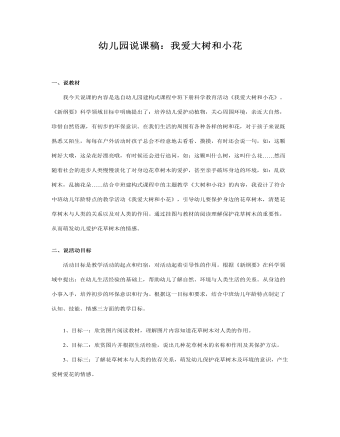
幼儿园中班说课稿:我爱大树和小花
二、说活动目标 活动目标是教学活动的起点和归宿,对活动起着引导性的作用。根据《新纲要》在科学领域中提出:在幼儿生活经验的基础上,帮助幼儿了解自然、环境与人类生活的关系。从身边的小事入手,培养初步的环保意识和行为。根据这一目标和要求,结合中班幼儿年龄特点制定了认知、技能、情感三方面的教学目标。1、目标一:欣赏图片阅读教材,理解图片内容知道花草树木对人类的作用。2、目标二:欣赏图片并根据生活经验,说出几种花草树木的名称和作用及其保护方法。3、目标三:了解花草树木与人类的依存关系,萌发幼儿保护花草树木及环境的意识,产生爱树爱花的情感。 (目标定位:通过欣赏图片阅读教材来了解花草树木对人类的作用,了解花草树木是怎样为人类服务的,萌发幼儿爱护花草树木的情感)三、说教法与学法 《新纲要》中强调幼儿是中心,教育活动应该以幼儿的需要,兴趣,尤其是幼儿的经验来进行,学决定教。在活动中我和幼儿的角色都是教学活动的主人翁,主要是以幼儿为主。让幼儿在教学活动中享受探究问题及解决问题的快乐。所以在教学活动中我采用了“图片观察法”运用直观、形象的图片进行欣赏,引导幼儿理解图片内容及其意思。“游戏法”通过游戏让幼儿亲身体验怎样爱护花草树木让幼儿更深一层的了解爱护花草树木需要做的事情,在游戏中让幼儿学会爱护花草树木的深刻内涵。四、说活动准备 活动中准备:挂图四幅、幼儿用书第37-38页、五幅环保画(例如:树木被破坏、花朵被摘……)、制作花朵大树头饰幼儿人数各一半
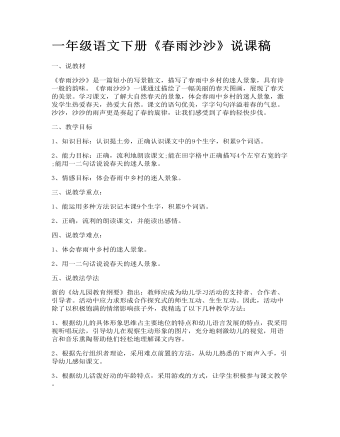
一年级语文下册《春雨沙沙》说课稿
二、教学目标1、知识目标:认识提土旁,正确认识课文中的9个生字,积累9个词语。2、能力目标:正确,流利地朗读课文;能在田字格中正确描写4个左窄右宽的字;能用一二句话说说春天的迷人景象。3、情感目标:体会春雨中乡村的迷人景象。三、说教学重点:1、能运用多种方法识记本课9个生字,积累9个词语。2、正确,流利的朗读课文,并能读出感情。四、说教学难点:1、体会春雨中乡村的迷人景象。2、用一二句话说说春天的迷人景象。五、说教法学法新的《幼儿园教育纲要》指出:教师应成为幼儿学习活动的支持者、合作者、引导者。活动中应力求形成合作探究式的师生互动、生生互动。因此,活动中除了以积极饱满的情绪影响孩子外,我精选了以下几种教学方法:1、根据幼儿的具体形象思维占主要地位的特点和幼儿语言发展的特点,我采用视听唱玩法,引导幼儿在观察生动形象的图片,充分地刺激幼儿的视觉,用语言和音乐熏陶帮助他们轻松地理解课文内容。
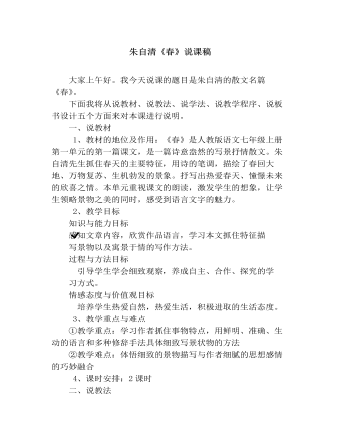
部编版语文七年级上册《春》说课稿
一、说教材1、教材的地位及作用:《春》是人教版语文七年级上册第一单元的第一篇课文,是一篇诗意盎然的写景抒情散文。朱自清先生抓住春天的主要特征,用诗的笔调,描绘了春回大地、万物复苏、生机勃发的景象。抒写出热爱春天、憧憬未来的欣喜之情。本单元重视课文的朗读,激发学生的想象,让学生领略景物之美的同时,感受到语言文字的魅力。2、教学目标知识与能力目标 感知文章内容,欣赏作品语言,学习本文抓住特征描写景物以及寓景于情的写作方法。过程与方法目标引导学生学会细致观察,养成自主、合作、探究的学习方式。情感态度与价值观目标培养学生热爱自然,热爱生活,积极进取的生活态度。3、教学重点与难点 ①教学重点:学习作者抓住事物特点,用鲜明、准确、生动的语言和多种修辞手法具体细致写景状物的方法②教学难点:体悟细致的景物描写与作者细腻的思想感情的巧妙融合
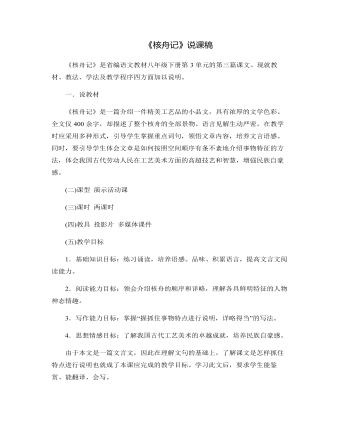
部编版语文八年级下册《核舟记》说课稿
(2)教学内容的设计,一般须遵从学生认知规律,由表及里,由浅入深、完整、生动地呈现事物或事理本身的美学价值。在整体感知课文的艺术美和解决文字障碍之后,通过动手做“核舟”、改写评点“解说词” ,使学生在动手做、动手改、动口说中,理清课文层次和说明顺序。最后,学生们再一次通读全文,使他们的认知经历了从语言文字到形象生动的表象,再到语言文字的完整过程。帮助他们将语言形式和语言内容紧密结合起来。吉尔伯特·海特在其《教学的艺术》一书中曾谈到:“如果我们不能获得一声出自内心的笑,那么这一天的教学就白费了”。通过演课本剧,加深了学生对课文的理解和记忆,有利于培养学生的思考能力,想象能力,逻辑思维能力和语言表达能力。也正是获取一声声出自内心的笑的一种行之有效的方法。
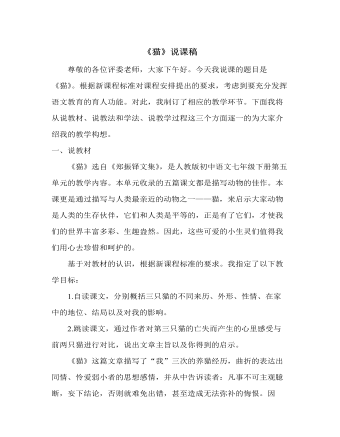
部编版语文七年级上册《猫》说课稿
一、说教材《猫》选自《郑振铎文集》,是人教版初中语文七年级下册第五单元的教学内容。本单元收录的五篇课文都是描写动物的佳作。本课更是通过描写与人类最亲近的动物之一——猫,来启示大家动物是人类的生存伙伴,它们和人类是平等的,正是有了它们,才使我们的世界丰富多彩、生趣盎然。因此,这些可爱的小生灵们值得我们用心去珍惜和呵护的。基于对教材的认识,根据新课程标准的要求。我指定了以下教学目标:1.自读课文,分别概括三只猫的不同来历、外形、性情、在家中的地位、结局以及对我的影响。2.跳读课文,通过作者对第三只猫的亡失而产生的心里感受与前两只猫进行对比,说出文章主旨以及你得到的启示。《猫》这篇文章描写了“我”三次的养猫经历,曲折的表达出同情、怜爱弱小者的思想感情,并从中告诉读者:凡事不可主观臆断,妄下结论,否则就难免出错,甚至造成无法弥补的悔恨。因此,我将教学目标的第一点:概括三只猫的不同来历、外形、性情、在家中的地位、结局以及对我的影响作为本课的教学重点。而说出文章主旨以及得到的启示作为本课教学难点。
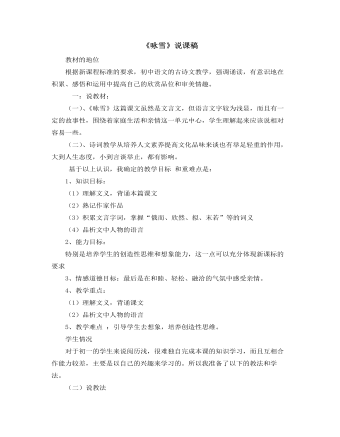
部编版语文七年级上册《咏雪》说课稿
学生情况对于初一的学生来说阅历浅,很难独自完成本课的知识学习,而且互相合作能力较差,主要是以自己的兴趣来学习的。所以我准备了以下的教法和学法。(二)说教法1、情景导入 教学为学生创设了良好的环境,使学生能迅速进入角色。2、朗读教学所谓'读书百遍,其义自见'通过朗读,培养了学生良好的朗读习惯和朗读文言文的语感。3、现场演示法可以更形象的体会优美的句子4、激励创新讲述,发展思维。通过这一环节的迁移训练,不但提高了学生的思维能力,而且拓展了学生的思维空间和想象能力。练习的设计能照顾到全体学生,体现层次性。5、淡化教师角色,体现学生主体地位。这堂课教师是作为一个协作者,对学生进行必要的指导,大部分时间都能体现学生参与学习的过程,学生是课堂的主体。(三) 说学法本人更注重师生之间的互动和学生与学生之间的互动,通过自问自答、自问他答或老师解答等形式,充分调动了学生学习的积极性。

《争做先锋——体育小达人》说课稿
《少先队活动课指导纲要》明确指出,要通过颁授“雏鹰奖章”,促进全面发展的成效进行评价,及时进行过程性评价激励。本节活动课,在评价环节设置了队员对队员的评价,小队间的评价,颁发“先锋章”的评价,符合《纲要》精神。活动延伸1.课后,将小队设计的体育游戏向别的小队、中队辐射;并鼓励其他小队、中队设计具有自身特色的体育游戏。2.搜集整理有关“行为习惯”资料,为下节课“争做先锋——文明小达人”做准备。活动反思1.少先队活动课应该培养队员掌控课堂的能力,以及学会处理课堂上一些突发情况的能力。虽说是五年级的队员,但辅导员老师还是应在课前进行培训。2. 活动课主题的选择,应从队员生活实际出发,从队员兴趣出发,引导队员积极参与。3.队课要向队员灌输正确的观念,本节活动课“争做先锋——体育小达人”符合这个要求。
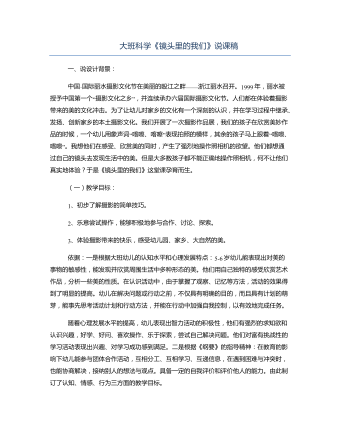
大班科学《镜头里的我们》说课稿
1、初步了解摄影的简单技巧。2、乐意尝试操作,能够积极地参与合作、讨论、探索。3、体验摄影带来的快乐,感受幼儿园、家乡、大自然的美。依据:一是根据大班幼儿的认知水平和心理发展特点:5-6岁幼儿能表现出对美的事物的敏感性,能发现并欣赏周围生活中多种形态的美。他们用自己独特的感受欣赏艺术作品,分析一些美的性质。在认识活动中,由于掌握了观察、记忆等方法,活动的效果得到了明显的提高。幼儿在解决问题或行动之前,不仅具有明确的目的,而且具有计划的萌芽,能事先思考活动计划和行动方法,并能在行动中加强自我控制,以有效地完成任务。
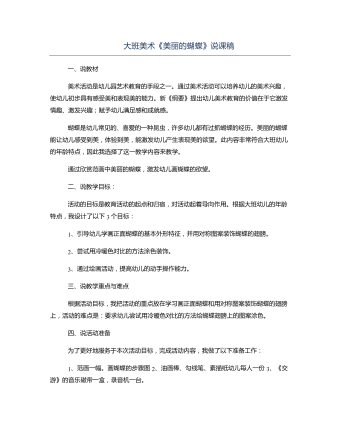
大班美术《美丽的蝴蝶》说课稿
美术活动是幼儿园艺术教育的手段之一。通过美术活动可以培养幼儿的美术兴趣,使幼儿初步具有感受美和表现美的能力。新《纲要》提出幼儿美术教育的价值在于它激发情趣、激发兴趣;赋予幼儿满足感和成就感。蝴蝶是幼儿常见的、喜爱的一种昆虫,许多幼儿都有过抓蝴蝶的经历。美丽的蝴蝶能让幼儿感受到美,体验到美,能激发幼儿产生表现美的欲望。此内容非常符合大班幼儿的年龄特点,因此我选择了这一教学内容来教学。通过欣赏范画中美丽的蝴蝶,激发幼儿画蝴蝶的欲望。活动的目标是教育活动的起点和归宿,对活动起着导向作用。根据大班幼儿的年龄特点,我设计了以下3个目标:1、引导幼儿学画正面蝴蝶的基本外形特征,并用对称图案装饰蝴蝶的翅膀。2、尝试用冷暖色对比的方法涂色装饰。3、通过绘画活动,提高幼儿的动手操作能力。
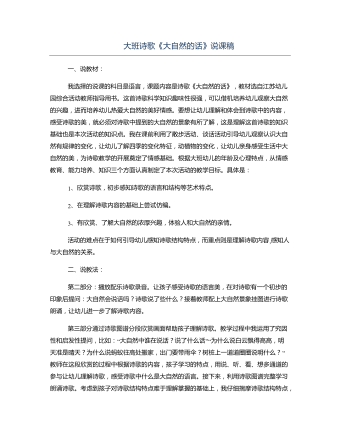
大班诗歌《大自然的话》说课稿
我选择的说课的科目是语言,课题内容是诗歌《大自然的话》,教材选自江苏幼儿园综合活动教师指导用书。这首诗歌科学知识趣味性很强,可以借机培养幼儿观察大自然的兴趣,进而培养幼儿热爱大自然的美好情感。要想让幼儿理解和体会到诗歌中的内容,感受诗歌的美,就必须对诗歌中提到的大自然的景象有所了解,这是理解这首诗歌的知识基础也是本次活动的知识点。我在课前利用了散步活动、谈话活动引导幼儿观察认识大自然有规律的变化,让幼儿了解四季的变化特征,动植物的变化,让幼儿亲身感受生活中大自然的美,为诗歌教学的开展奠定了情感基础。根据大班幼儿的年龄及心理特点,从情感教育、能力培养、知识三个方面认真制定了本次活动的教学目标。具体是:1、欣赏诗歌,初步感知诗歌的语言和结构等艺术特点。2、在理解诗歌内容的基础上尝试仿编。3、有欣赏、了解大自然的浓厚兴趣,体验人和大自然的亲情。

大班美术欣赏《向日葵》说课稿
《向日葵》是法国伟大的画家凡高的作品。观者在观看此画时。无不为其中激动人心的画面效果而感应,心灵为之震颤,激情也喷发而出.无不跃跃欲试,共同融人到凡高丰富的主观感情中去。总之,凡高笔下的向日葵不仅仅是植物,而是带有原始冲动和热情的生命体。在《向日葵》这幅作品中,值得幼儿欣赏和学习的是:画面中鲜明亮丽的色彩和极富特色的线条,感受画面传达出来的强烈、炙热的感情。然而对于城市的大班幼儿来说,孩子缺乏对“向日葵”这种植物的真实的感知,孩子不知道向日葵这种植物的外形、色彩、特征以及它的象征。而这些恰恰正是欣赏《向日葵》这幅作品的经验基础。新《纲要》强调:“幼儿的学习要来源于幼儿的生活,以生活为基础,建立在生活之上。”
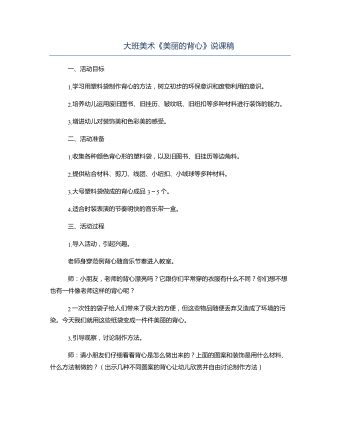
大班美术《美丽的背心》说课稿
1.导入活动,引起兴趣。老师身穿范例背心随音乐节奏进入教室。师:小朋友,老师的背心漂亮吗?它跟你们平常穿的衣服有什么不同?你们想不想也有一件像老师这样的背心呢?2一次性的袋子给人们带来了很大的方便,但这些物品随便丢弃又造成了环境的污染。今天我们就用这些纸袋变成一件件美丽的背心。3.引导观察,讨论制作方法。师:请小朋友们仔细看看背心是怎么做出来的?上面的图案和装饰是用什么材料、什么方法制做的?(出示几种不同图案的背心让幼儿欣赏并自由讨论制作方法)总结:先把塑料袋下面的缝合处用剪子剪开,再从图书上把自己喜欢的图案剪下来,拼贴在背心上,也可以用皱纹纸做成蝴蝶结、剪成花边,或选一些好看的纽扣、绒球进行装饰,这样一件漂亮的背心就做好了。4.幼儿操作,教师指导。师:把你最喜欢的动物和图案剪下来贴在背心上,可以贴对称的,也可以贴不对称的。花边一般比较有规律,颜色可以用同色,可用多种色,也可以用单色或变换色,只要协调大方就行了。
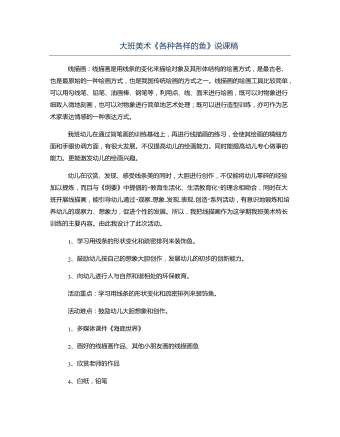
大班美术《各种各样的鱼》说课稿
幼儿在欣赏、发现、感受线条美的同时,大胆进行创作,不仅能将幼儿零碎的经验加以提炼,而且与《纲要》中提倡的“教育生活化、生活教育化”的理念相吻合,同时在大班开展线描画,能引导幼儿通过“观察-想象-发现-表现-创造”系列活动,有意识地锻炼和培养幼儿的观察力、想象力,促进个性的发展。所以,我把线描画作为这学期我班美术特长训练的主要内容。由此我设计了此次活动。1、学习用线条的形状变化和疏密排列来装饰鱼。2、鼓励幼儿按自己的想象大胆创作,发展幼儿的初步的创新能力。3、向幼儿进行人与自然和谐相处的环保教育。活动重点:学习用线条的形状变化和疏密排列来装饰鱼。活动难点:鼓励幼儿大胆想象和创作。
